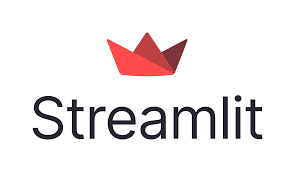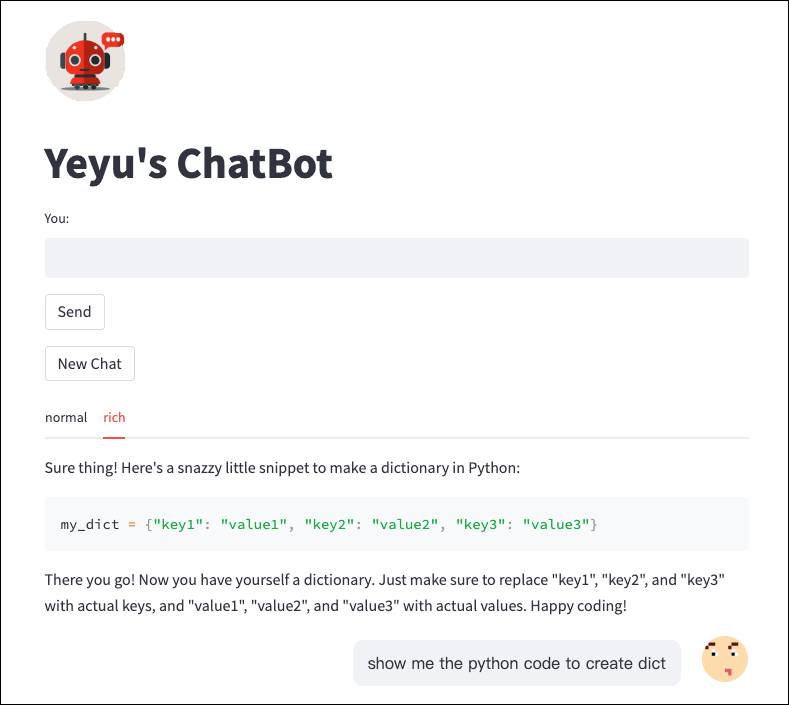After “ChatGPT API” was released on Mar.1, 2023, thousands of applications around the APIs have been developed, opening up a new era of possibilities for businesses and individuals. With GPT-3.5’s natural language processing capabilities, users can create chatbots that can seamlessly interact with people, for various purposes like answering questions, making novels, accounting, and even providing therapy. The potential uses of this API are limited only by people’s imagination, and it’s exciting to see how developers will continue pushing the boundaries of what’s possible with AI in the future.
I know there are enough tutorials on the Internet for the past week, however, it’s still worth writing about an end-to-end working guide about the usage of ChatGPT API, Streamlit, and Docker to release a decent website for yourself, your friends, or a small business, in a very short time.
Why need
There are reasons why we need to create our own chatbot website:
We are all aware of the difficulties in smoothly logging in and using the free version of ChatGPT, due to its high daily traffic. While the pro version is available at a cost of $20 per month, it may not be a cost-effective option for casual users who do not require advanced features. A “pay as you go” model would be more appealing to many users who only require occasional usage of the platform. However, ChatGPT does not offer this option.
Fortunately, the recently released Chat Completion API (aka. ChatGPT API) utilizes GPT-3.5-turbo models at a cost of just $0.002 per 1k tokens. This presents a much more affordable option for common usage when the API access is much more stable with no peak traffic troubles. Furthermore, building a website to chat using GPT 3.5 (the same model employed by ChatGPT) via API does not make you tolerate the slow “thinking” and “typing” response time that ChatGPT spends to mimic human beings. All chatting responses are quick and straightforward.
Although your initial website may appear basic, once you’ve created it, adding additional features will become a breeze, enabling you to reach your commercial potential.
Enough for theory, let’s start.
Create OpenAI API keys
If you’ve already requested OpenAI API Key in your account, you can keep using that one instead of generating a new one.
If this is your first to OpenAI API, please sign up for a new OpenAI account and find the below page from your account menu:

Please be aware that the entire API key will be only displayed once after generation, so you have to copy it somewhere safe for further usage. (I copied mine directly to the code for only demonstration purposes which is not recommended for your applications)
Chat Completion APIs
The newly released “ChatGPT” API is called Chat completion, and the documentation can be found here.
The usage is very straightforward even if you have no experience with other OpenAI APIs before. To have an answer from GPT-3.5, from its official introduction, all you need to do are:
Install the package
!pip install openai
import the module
import openai
Create and send the prompt
complete = openai.ChatCompletion.create(
model="gpt-3.5-turbo",
messages=[
{"role": "system", "content": "You are a helpful assistant."},
{"role": "user", "content": "Who won the world series in 2020?"},
{"role": "assistant", "content": "The Los Angeles Dodgers won the World Series in 2020."},
{"role": "user", "content": "Where was it played?"}
]
)
Receive the response
message=complete.choices[0].message.content
There is a new usage of message body compared to other legacy GPT models. The list of messages will contain several objects of messages which perform the feature of “Chat”.
The system, user, and assistant are the three roles newly defined in the message objects. The system message is defined to set the behavior of the chatbot by adding an instruction in the content. Still, as mentioned in the introduction, currently this power has not been fully released in gpt-3.5-turbo-0301 yet. The user message represents an input or inquiry from the user, while the assistant message refers to the corresponding response from the GPT-3.5 API. This dialog exchange simulates a human-like conversation, with the user message initiating the interaction and the assistant message providing a relevant and informative answer to give the chat model the context of this conversation to generate a more relevant response later on. The last user message refers to the prompt requested at the current moment.
Streamlit & Streamlit_chat
Streamlit is an open-source framework that enables data scientists and developers to quickly build and share interactive web applications for machine learning and data science projects. It also offers a bunch of widgets that only required one line of python code to create like st.table(…). For our purpose of creating a simple Chatbot website for private usage, Streamlit is a quite suitable library with a third-party Streamlit_chat library which provide further convenience to generate a “Chat-style” web application as we don’t have to deal with a lot of HTML elements and CSS stuff.

To set up a website and release it on the Internet, only a few steps are required:
Install the package
!pip install streamlit
Create a Python file “demo.py” with the below code
import streamlit as st
st.write("""
# My First App
Hello *world!*
""")
Run on your local machine or remote server
!python -m streamlit run demo.py
After this output is printed, you can visit your web through the address and port listed:
You can now view your Streamlit app in your browser.
Network URL: http://xxx.xxx.xxx.xxx:8501
External URL: http://xxx.xxx.xxx.xxx:8501
Build the ChatBot application
The running data for web operations are all managed by the object session_state of Streamlit. We defined prompts list to store the prompts’ messages which start from the system role message and are appended by the user and assistant on every chat generated.
For the system role message, I have put additional instruction “with a little humor expression” into the content and it really looks working, because when I ask how to become a billionaire, it recommends robbing a bank for kidding… such settings remind me of “TARS” in the movie “Interstellar”.
Another two session_state are used to store all API responses (generated), and all user prompts (past) for display pair by pair in chat style with Streamlit_chat function message().
There are two buttons created by the Streamlit widget, Send to activate ChatCompletion request and New Chat to clean up the chat history in both prompts object and chatting display. These behaviors are defined in the callback function chat_click() and end_click().
To fully duplicate ChatGPT’s user experience, we also need to consider the display of full markdown features from API responses like code snippets, tables, etc. Unfortunately, the chatting bubble by streamlit_chat cannot display markdown contents very well so I use the tabs widget to separate the plain text in bubble display as normal and markdown display as rich in the case of structured text like code.

The entire Python code is pasted below which you can directly copy:
import openai
import streamlit as st
from streamlit_chat import message
openai.api_key = '{Your API key}'
if 'prompts' not in st.session_state:
st.session_state['prompts'] = [{"role": "system", "content": "You are a helpful assistant. Answer as concisely as possible with a little humor expression."}]
if 'generated' not in st.session_state:
st.session_state['generated'] = []
if 'past' not in st.session_state:
st.session_state['past'] = []
def generate_response(prompt):
st.session_state['prompts'].append({"role": "user", "content":prompt})
completion=openai.ChatCompletion.create(
model="gpt-3.5-turbo",
messages = st.session_state['prompts']
)
message=completion.choices[0].message.content
return message
def end_click():
st.session_state['prompts'] = [{"role": "system", "content": "You are a helpful assistant. Answer as concisely as possible with a little humor expression."}]
st.session_state['past'] = []
st.session_state['generated'] = []
st.session_state['user'] = ""
def chat_click():
if st.session_state['user']!= '':
chat_input = st.session_state['user']
output=generate_response(chat_input)
#store the output
st.session_state['past'].append(chat_input)
st.session_state['generated'].append(output)
st.session_state['prompts'].append({"role": "assistant", "content": output})
st.session_state['user'] = ""
st.image("{Your logo}", width=80)
st.title("My ChatBot")
user_input=st.text_input("You:", key="user")
chat_button=st.button("Send", on_click=chat_click)
end_button=st.button("New Chat", on_click=end_click)
if st.session_state['generated']:
for i in range(len(st.session_state['generated'])-1, -1, -1):
tab1, tab2 = st.tabs(["normal", "rich"])
with tab1:
message(st.session_state['generated'][i], key=str(i))
with tab2:
st.markdown(st.session_state['generated'][i])
message(st.session_state['past'][i], is_user=True, key=str(i) + '_user')
After the streamlit command executed, your ChatBot website will go live on http://{Your IP address}:8501 as default!
!python -m streamlit run demo.py
Another two optional steps
Ask users or yourself to visit your ChatBot by typing http://111.22.333.44:8501 looks a little unprofessional so please consider another two steps to finalize your go-live.
Use a domain name instead of an IP address
You can try to buy a cheap domain with strong personal branding on https://www.namecheap.com/ and direct it to your server IP in Namesilo’s management panel.
Deploy on port 80
As Streamlit does not support taking over port 80 for your web service port, if you want to prevent the users from typing something like:8501 to visit your website, you could deploy your Streamlit application using Docker and use Docker to map port 80 to your actual Streamlit port.
The tutorial for setup Docker and running your Streamlit application in it can be found here.
Please feel free to contact me for any development issues and also ask for my demo web address (sorry I cannot share it in the article as the usage of OpenAI API costs me money…)
That’s it.
Hope you can find something useful in this article and thank you for reading!













